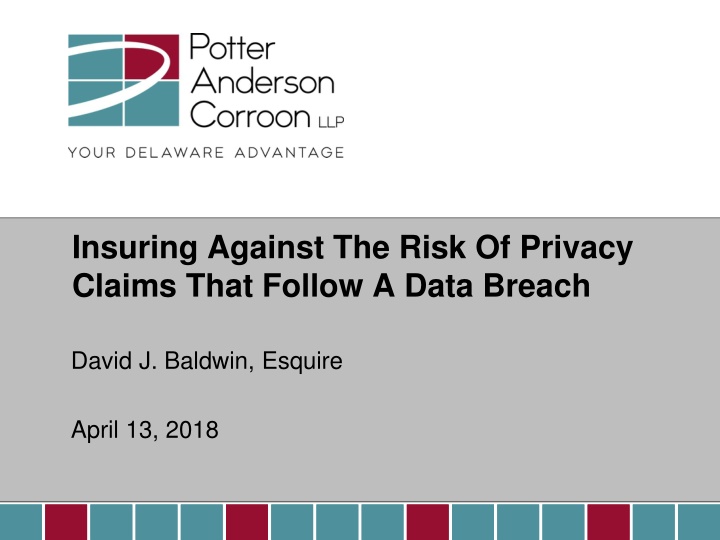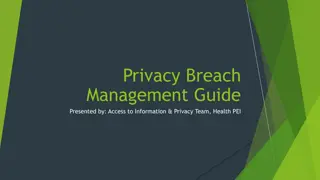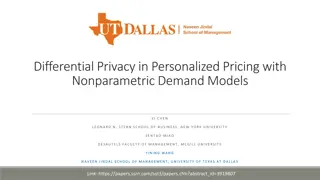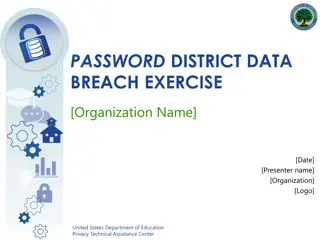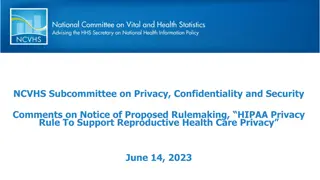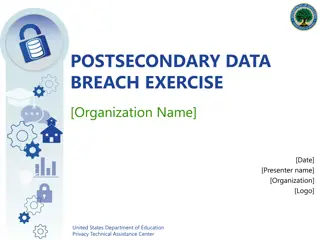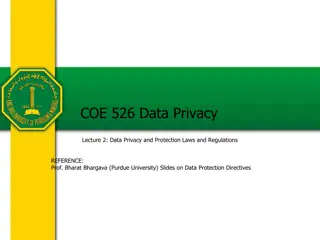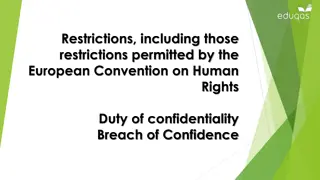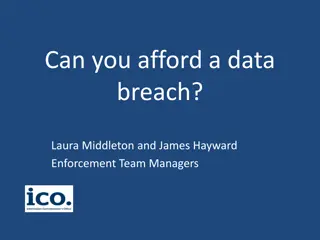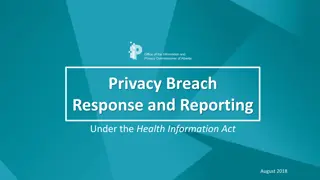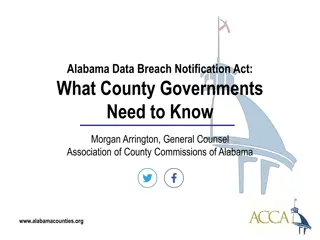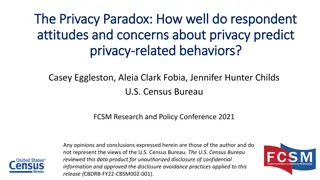Managing Privacy Risks After a Data Breach
Exploring the legal implications and risks of privacy claims following a data breach, with examples such as the Veridian Credit Union v. Eddie Bauer case. Discusses the duty of care, liability under state laws, and the importance of safeguarding sensitive information like biometric identifiers.
Download Presentation

Please find below an Image/Link to download the presentation.
The content on the website is provided AS IS for your information and personal use only. It may not be sold, licensed, or shared on other websites without obtaining consent from the author.If you encounter any issues during the download, it is possible that the publisher has removed the file from their server.
You are allowed to download the files provided on this website for personal or commercial use, subject to the condition that they are used lawfully. All files are the property of their respective owners.
The content on the website is provided AS IS for your information and personal use only. It may not be sold, licensed, or shared on other websites without obtaining consent from the author.
E N D
Presentation Transcript
Insuring Against The Risk Of Privacy Claims That Follow A Data Breach David J. Baldwin, Esquire April 13, 2018
What Could Possibly Go Wrong? 2 2
One Example (Of Many): Privacy Litigation Veridian Credit Union v. Eddie Bauer, LLC, 2017 WL 5194975 (W.D. Wash. Nov. 9, 2017). 3
Eddie Bauer Hackers installed malware on computers in Eddie Bauer stores; stole consumer credit and debit card information. Veridian (issuer of payment cards that were compromised in the breach) sued. Claims included: negligence, negligence per se, and violation of Washington Revised Code 19.255.020. Negligence per se dismissed (no separate cause of action in WA). No common law duty to prevent criminal act of third party, because no special relationship and no allegation of affirmative act by Eddie Bauer that put Veridian in peril. BUT 4
Eddie Bauer (contd) Washington Revised Code 19.255.020 Imposes liability on businesses that fail to exercise reasonable care against unauthorized access of unencrypted credit or debit card information, where failure to exercise reasonable care is the proximate cause of a breach. Such businesses must reimburse financial institutions for the reasonable actual costs related to reissuance of credit cards and debit cards. Plaintiffs can recover attorneys fees and costs. Veridian had a cause of action under Section 19.255.020. Veridian s negligence claim could proceed because Eddie Bauer owed Veridian a duty of reasonable care predicated on Section 19.255.020. 5
Choice of Law Because duty can be predicated on state law, which state s law controls may impact the claims available. In Eddie Bauer, Eddie Bauer sought to avoid application of Washington law (its home state). Eddie Bauer argued that the location of the harmful act was unknown because the cyber criminals were not identified. The court rejected this argument, noting that the alleged negligent act was the failure of Eddie Bauer to exercise reasonable care to safeguard the credit and debit card information. 6
Biometric Information Privacy Act (BIPA) Illinois: 740 Ill. Comp. Stat. 14/15(e) Protects biometric identifiers, such as fingerprints and face scans. Imposes notification and consent requirements. Also, companies must use reasonable standard of care to protect this information. Private right of action: $1,000 per negligent occurrence; $5,000 per intentional/reckless occurrence. Plaintiffs must allege some actual harm. Rosenbach v. Six Flags Entm t Corp., 2017 WL 6523910 (Ill. App. Ct. Dec. 21, 2017). 7
Risks Associated With Statutory Claims Statutes may provide right to fee-shifting or liquidated damages. Statute may support plaintiff s negligence claim (by establishing duty or the applicable standard of care). Violation (or allegations thereof) may result in denial of coverage if the relevant policy excludes coverage for statutory violations. Benefit? Some states provide safe harbors for companies that implement encryption programs or take other recognized steps to safeguard consumer data. 8
Breach Disclosure Statutes Exist in nearly all states in some form. Reporting obligation: At a minimum, notice to consumers reasonably believed to have been affected. Upon meeting certain thresholds (usually of quantity of people affected), the company may also be required to report to the state attorney general and/or credit reporting agencies. Some states require companies to offer free credit monitoring services to affected consumers if certain sensitive information is involved. Similar obligations may apply under federal law (e.g., HIPAA). 9
Types of Policies that Might Cover Privacy Claims CGL Policies Coverage A Coverage B Other Policies Crime D&O Cyber Policies 11
Privacy Claim Coverage Under CGL Policies Most cyber-related insurance litigation has involved CGL Policy coverage. Coverage B Covers oral or written publication, in any manner, of material that violates a person s right of privacy. ISO Form CG 00 01 12 07 Issues Arising From Coverage B Claims For Data Breaches Coverage of statutory violations. When does a data breach equal publication ? Does it matter who actually publishes the information in question? Is it necessary that a third party access the information? 12
Coverage B (contd) Statutory violations may be excluded from CGL policies. Big 5 Sporting Goods Corp. v. Zurich American Insurance Company, 635 F. App'x 351 (9th Cir. 2015). Policy barred coverage for violation of a person s right of privacy created by state or federal statute. Claims alleged ZIP code violations of the Song-Beverly Act, a California statute that prohibited entities accepting credit cards from providing personal information, such as ZIP codes. The Ninth Circuit upheld the lower court s denial of coverage because it found that the only possible claims were for statutory penalties. 13
Coverage B (contd) Publication Issues Coverage has been denied when perpetrated by a third party. Innovak International, Inc. v. Hanover Insurance Company, 280 F. Supp. 3d 1340, (M.D. Fla. 2017). Provided payroll computer software used in schools. Hackers infiltrated Innovak s internet portal and appropriated personal private information from Innovak s customers. The Court found that there was no coverage because there was no publication by Innovak. Rather, the alleged publication was perpetrated by the hackers. Zurich American Insurance Co. v. Sony Corp. of America et al., 651982/2011, the Supreme Court of New York, County of New York. Similarly found that there was no coverage under CGL policy because the policy requires the policyholder to commit the act of publication, and it cannot be expanded to third-parties. The case was appealed to an appellate panel but settled after oral argument. 14
Coverage B (contd) Additional Publication Issues Information may only be considered published if it is also accessed ? Recall Total Information Management, Inc. v. Federal Ins. Co., 83 A.3d 664 (Conn. App. Ct. 2014), aff d, 115 A.3d 458 (Conn. 2015). IBM contracted with Recall Total to transport and store certain electronic records which contained personal information of thousands of employees. While transporting records, a cart of tapes containing personal information fell from the truck. Before the cart was recovered, 130 tapes were removed and never retrieved. The issue for the court was not whether the information had been lost, but rather whether it had been published. Publication requires the communication of information, which means that the information must be accessed, not merely available. 15
Coverage B (contd) Additional Publication Issues Access is not always required. Travelers Indemnity Company of America v. Portal Healthcare Solutions, LLC, 35 F. Supp. 3d 765, 767 (E.D. Va. 2014), aff d, 644 F. App x 245 (4th Cir. 2016). Portal was in the business of electronically storing medical records for hospitals. It failed to properly safeguard private information, and, as a result, the information was posted publicly on the internet. Policy covered publication that resulted in an invasion of privacy. Despite a lack of evidence that anyone had accessed the information, Portal was still entitled to coverage because the medical records potentially or arguably were placed before the public. 16
Privacy Claim Coverage Under CGL Policies Coverage A Covers bodily injury and property damage. Some writers have suggested that coverage may be available under coverage A following a data breach where the loss of personal or private information could create emotional distress. In Innovak, the underlying claims alleged that the loss of their information had caused them to suffer psychic injuries, including stress, nuisance, loss of sleep, worry, and the annoyance of having to deal with issues resulting from the Innovak data breach. However, the Court did not consider these issues because Innovak did not seek coverage under Coverage A of their policy. Whether data qualifies as property for purposes of Coverage A is still debated, but many insurers have expressly excluded electronic data from their definition of tangible property. 17
Evolution of the ISO Forms The trend is to write coverage for cyber-related events out of commercial general liability policies. The standard CGL ISO form now excludes damages arising out of the loss of, loss of use of, damage to, corruption of, inability to access, or inability to manipulate electronic data. In 2014, the ISO added an exclusion that excludes under Coverages A and B coverage for injury or damage arising out of any access to or disclosure of any person s or organization s confidential or personal information, including patents, trade secrets, processing methods, customer lists, financial information, creditor card information, health information or any other type of nonpublic information. 18
Other Policies that May Cover Certain Cyber Risks Crime Policies Policyholders must ensure that their policies cover actions of their own employees that are induced by criminals. Principle Sols. Grp., LLC v. Ironshore Indem., Inc., 2016 WL 4618761 (N.D. Ga. Aug. 30, 2016). Criminals convinced employee of the insured to approve certain fraudulent wire transfers. The insured had a crime policy covering Computer and Funds Transfer Fraud that covered loss resulting from a fraudulent instruction to a financial institution to transfer, pay, or deliver money. The Court upheld a denial of coverage because the transfer in question was not actually made by the criminals but was made legitimately by the employee. 19
Other Policies that May Cover Certain Cyber Risks (cont d) Director and Officer Policies Following many recent large-scale data breaches, there has been litigation filed against the directors and officers of the companies whose records were exposed. Examples include: Equifax, Wendy s, Yahoo!, Home Depot, Target, Wyndham, Heartland Payment, Choicepoint* Because many large cyber breaches also result in D&O litigation, D&O policies should be designed to respond to these risks. *For more information, see Kevin Kalinich, Jacqueline Waters, Chris Rafferty, Is Cyber Risk a D&O Risk? 20
Cyber Policies Market for Cyber Policies is Growing Rapidly Estimates reach $4 billion in premiums in 2017, up 25% over 2016 s estimated $3.25 billion in premiums.* Room for Growth Less than 15% of companies have cyber policies.** Categories of Coverage Liability defense and settlement costs for liability arising out of failure to properly care for private data. Remediation responds to costs following a data breach, including investigation, public relations, customer notification, and credit monitoring. Fines and/or Penalties costs to investigate, defend, and settle fines and penalties that may be assessed by a regulator, which typically include forensic and card reissuance costs. *Data provided in The Betterley Report, Cyber/Privacy Insurance Market Survey ** Data provided in the Aon Inpoint Global Cyber Market Overview 21
Pitfalls of Cyber Policies Cyber policies are still in their infancy, meaning that policyholders should take care to understand what types of cyber events can be covered and what may trigger coverage. Litigation involving cyber policies is limited, but courts will look to how cyber events have been treated under CGL policies for guidance. P.F. Chang s China Bistro, Inc. v. Federal Insurance Company, 2016 WL 3055111 (D. Ariz. May 31, 2016). P.F. Chang s held a cyber policy covering direct loss, legal liability, and consequential loss resulting from cyber security breaches. Hackers appropriated approximately 60,000 credit card numbers of P.F. Chang s customers. Insurer provided coverage for class action but denied coverage relating to assessments MasterCard imposed on Bank of America (P.F. Chang s credit card processor). Because P.F. Chang s had contractually agreed to reimburse Bank of America for the MasterCard assessments, it was not entitled to coverage under the cyber policy based on an exclusion that excluded liabilities assumed under contract. 22
Coverage Takeaways 23 23
Maximize Coverage For Privacy Claims Watch for exclusions involving: Statutory violations. Contractual obligations to third parties triggered by a data breach. The policy should cover the loss irrespective of: Whether the insured or a third party is responsible for the breach. Whether the breach resulted from an act or omission. Whether there is evidence of misuse of the data by a third party. Whether the damage is only to data or other intangible property. Also be sure that informal regulatory investigations and compliance with reporting requirements are covered. 24
Contact Information David J. Baldwin, Esquire Direct dial: 302.984.6017 dbaldwin@potteranderson.com Potter Anderson & Corroon LLP 1313 North Market Street P.O. Box 951 Wilmington, DE 19899-0951 David J. Baldwin, Jennifer Penberthy Buckley, and D. Ryan Slaugh, Insuring Against The Risk of Privacy Claims Following a Data Breach, 122 PA. ST. L. REV. (forthcoming May 2018). 25
